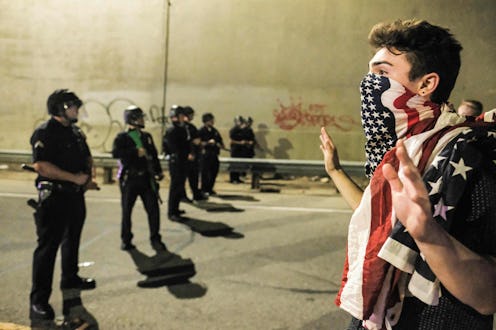Life
How Young People Are Reacting To The Election
In an upset that shocked the country, Donald Trump became the president-elect of the United States following Tuesday's election. Reactions have been mixed, to put it mildly, and a quick scroll through the #YouthRevolt Twitter hashtag makes it clear that many young people are frustrated with the results of the election. Exit polls have revealed a deep generational divide among voters; according to the Pew Research Center, adults over 65 preferred Trump to Hillary Clinton by a respectable margin of eight percent. Among adults under 30, however, that margin jumps to 18 points — in Clinton's favor. Exit polls aren't infallible, but there is an undeniable preference for Clinton among young people.
With this in mind, it's perhaps unsurprising that thousands of frustrated citizens poured into the streets of cities around the country to protest the election results on Wednesday, often gathering around Trump properties. Young people came together online as well, sharing videos of protests and calling for change on Twitter. Scrolling through #YouthRevolt, it becomes clear that protesters aren't just people who voted in the election. Their ranks also include a substantial number of high school students — teenagers who weren't old enough to vote in the election, but will be affected by the cost of Trump's presidency for years to come.
Others weren't young themselves, but they applauded students for speaking out.
The case could be made that the current generation of teenagers will feel the effects of the current political climate most strongly, as they will come of age directly in the middle of Trump's upcoming four years in office. Maybe this is one of the reasons why young people are protesting his presidency so strongly — the backlash hasn't been restricted to Twitter. High school students have staged walkouts in cities across the country, including Boulder, Colo., and Seattle, Wash., according to The Intercept.
The most extensive protests, however, were organized by students in the San Francisco Bay area, where thousands walked out in several different schools. According to CBS SF, a high school in San Jose staged a rally attended by several hundred students. About 1,500 teenagers participated in a protest beginning Wednesday morning at Berkeley High School and ending in a march to the nearby University of California, Berkeley, campus.
Of course, it wasn't just high school students who have been protesting. Elsewhere in California, the Los Angeles Times reports that young protesters burned a giant Trump head in effigy on the steps of Los Angeles City Hall, and many demonstrators across the country are Millennials or younger. The protests have been peaceful so far, focusing on criticizing Trump's campaign for encouraging sexism, racism, and similarly bigoted ideologies.
Although the election's results were a shock to many Americans, they reflect ideological differences that have been growing for some time now: Divisions by race, class, gender, and of course, age. The white vote was instrumental in electing Trump to office, but between exit polls and the protests across the country, it's clear that generational differences contributed as well. In fact, an interactive map by Survey Monkey that became popular in the days since the election shows that if it had been up to Millennial voters, Clinton would have won by a landslide. However, many Millennials didn't show up to vote.
So if you're frustrated, scared, or feeling powerless in the aftermath of Trump's election, you're not alone — young people across the country feel the same way. But as Clinton said in her moving concession speech on Wednesday, it's vital not to become cynical or lose hope in the coming years. "I know we have still not shattered that highest and hardest glass ceiling, but someday, someone will, and hopefully sooner than we might think right now," she said. That moment hasn't come yet, but one day, it will.
